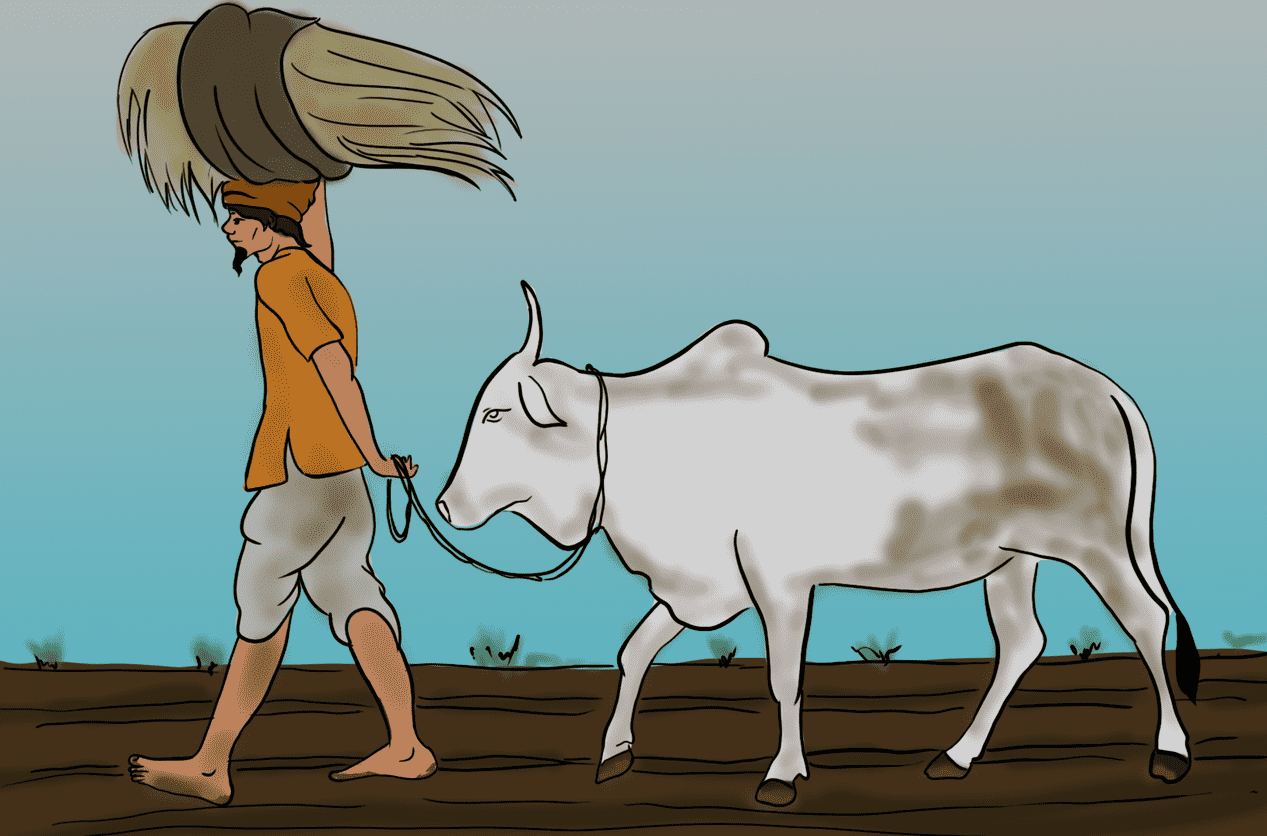Perceptions on farming: Stories from Bundelkhand
Prachi Shukla holds an M.Sc. in Geography from the University of Calcutta. Her research interests include agriculture, environment, economic and political geography.
I decided that I could not do better than watch the operations of these peasants and acquire their traditional knowledge as rapidly as possible. For the time being, therefore, I regarded them [Indian peasants] as my professors of agriculture.
Sir Albert Howard (An Agricultural Testament, 1943)
Today, that ancient wisdom is severely endangered, though not completely lost, by the ramifications of industrial chemical-based farming. The use of synthetic inputs has damaged the natural fertility of soils, the diversity of soil life, and the great variety of indigenous seeds which were suited to particular agro-climatic conditions. Notwithstanding the increased production volume attained due to the use of new seeds, chemical fertilizers, pesticides, weedicides, etc., what we have rapidly lost is the nutritive quality of foods. And though we may claim today that we are more food-secure than ever before, we cannot deny the fact that our overall well-being has declined despite a quantitatively ‘food-secure’ scenario. This is because food security is not just the access to sufficient amounts of food but also an acceptable quality of food.
Following are some life stories narrated by the ‘professors’ themselves- stories about the pre-Green Revolution farming, food diversity, chemical farming and their restrictive impacts on farmers’ autonomy, return to organic farming, and problems encountered in making possible a return to prosperity.
The district of Banda is a part of the Bundelkhand division of Uttar Pradesh. Bundelkhand is also a separate agro-climatic zone among the total of nine such zones in the state. This region has great geographical diversity. It can be classified into three subdivisions on the basis of topography: (1) Bundelkhand Plain – including nearly level regions of Jalaun Plain, Hamirpur Plain and Banda Plain; (2) Bundelkhand Intermediate Zone- Jhansi and Lalitpur districts; (3) Bundelkhand Upland or Plateau- southern parts of Lalitpur and Chitrakoot districts.
Bundelkhand is an important pulses (tur, moong, urad, black gram) and oilseeds (mustard and peanut) production centre. Rice and wheat are grown in areas with suitable soils and availability of irrigation. The soil types found here are four: rakar (coarse- grained reddish brown, found at higher elevations or sloping surfaces ), parua ( coarse-grained grey to greyish brown alluvial soils with calcareous accumulations), kabar (clay-loam black soils) and mar (fine clayey black soils). The region experiences a hot and semi-humid climate. The mean summer temperature is around 30°C which may go beyond 40°C in May and June, and the annual precipitation varies between 850mm and 1044 mm (NABCONS, n.d.). However, the rainfall is very erratic in character. The non-uniform nature of rainfall causes severe droughts in this zone. The rocky terrain and shallow soils in the uplands allow little underground percolation of rainwater, leading to rapid runoff and floods in low-lying areas. The districts of Jalaun, Hamirpur, Mahoba, Banda and Chitrakoot are categorised as ‘drought prone’. In terms of overall development, Bundelkhand is counted among the least developed regions of India.
Notwithstanding the physiographic constraints, Bundelkhand has a unique and rich cultural heritage ranging from its linguistic identity embedded in the Bundeli or Bundelkhandi dialect, to its folk songs ( the Alha being the most famous one).
The scenario of agriculture as described in detail by a few cultivators in different parts of Banda is apparently the reflection of not just Bundelkhand, but the millions of Indian farmers.
- Ram Kishor Ji
Ram Kishor Ji, 65-year old, lives in Jarar village in Naraini Block, where much of the land remains unirrigated and only one crop is taken per year. He is a graduate (B.A.) and works in the village school. He says that there is large-scale migration of young men and women to the towns in search of jobs, as agriculture contributes almost ‘nothing’ to the family income. Sometimes when the lone crop fails, returns from agriculture become nil.
However, the scenario was not always the same. There is a big difference between the early and the modern systems of agriculture. Rainfall was sufficient in those days. But now droughts and floods take place intermittently. He says that before the Green Revolution, every village household had at least 6 to 7 animals. Each family had their own compost pit. Green manure crops were sown at a particular place in the field and the next year its location was shifted. People followed a proper crop cycle. At the same time, a variety of crops- jowar, arhar, moong, urad, beans were sown. Gram, barley, mustard, indigenous wheat (such as kathiya) and rice (such as the mahachinnavar, gurmathiya) varieties were grown and were available in plenty. These crop varieties were suited to their agro-climatic zone. The food was tasty, the milk was pure. The ‘ghee’ that was being prepared in those days spread a distinct aroma, which is now lost forever. Wheat rotis, which were then served only to guests, replaced the rotis made of barley and gram. A return to organic farming is difficult. Now, he doesn’t have any livestock.
- Jag Prasad Ji
Jag Prasad Ji, a middle-aged farmer from the same village, was a migrant labourer in Noida one year ago. He returned home during the Covid-induced lockdown and has now taken up his family occupation. For the last year, he has been doing cultivation without any chemicals. He lives with his family in a hut in the middle of the farm. He plans to use organic compost henceforth as an improvement over existing pit composting, and is eager to adopt efficient irrigation techniques like sprinkler/drip with the help of a local NGO.
- Lallu Bhai Ji
Lallu Bhai Ji is a progressive farmer who lives with his sons, daughters and grandchildren, in this hamlet named Narsinghpur of Naraini Block which overlooks the distant Panna Ranges of Madhya Pradesh. This specific region is nearly untouched by the impacts of synthetic fertilizers and pesticides due to its remoteness. The system of agriculture here comprises the use of animal manure as compost, mixed cropping and crop rotation, and these are, he considers, the main factors that their lands give sufficient production which exceeds the yields obtainable from non-organic farming. He is able to grow everything that the family needs from the field- cereals, pulses and vegetables. His entire family is engaged on the farm with him.
The field is always covered with some crop and never left fallow. A part of his 5-acre land has a garden with several fruit trees of mangoes, pears and oranges. About ten years ago, when artificial irrigation could not be done in their village (local NGOs have played a major role in making bunds and taking other measures for water retention and conservation in this place), he started planting the trees. When asked about how old the garden is, he smiles and says that it has been ten years since he first planted those saplings. As sufficient water was not there for growing the plants, he would lift containers of water on his shoulders after filling them from a tap in a nearby school.
He remarks proudly that his farming is satisfactory and is giving optimum production.
- Sat Bhushan Ji
Sat Bhushan Ji, a 59-year-old cultivator from Badokhar Khurd village, on being asked what are the possible solutions to farmers’ problems, quotes:
“Sur Nar Muni sabke yah reeti,
Ramcharitmanas
Swaarath laagi karahin sab preeti”
(Everybody whether a deity, saint or common man, is always guided by their personal greed in whatever they do)
Sat Bhushan Ji talks about the older times when the joint family system was the rule and family members divided work appropriately and on the principle of equity. Somebody took care of the things which were to be brought from the market, somebody was totally occupied in crop production, someone was always looking after the livestock, and someone did business for additional income. However, everybody received an equal share of the gross produce. He says that even if one starts a simple life and is determined to practice farming by obeying natural laws, the production and income would be less. This would dissatisfy the family. He himself may be satisfied by pure food but the nature of the economy is such that he would not be compensated for his ‘good deeds’ of not using chemicals in farming.
According to him, everyone cannot adopt organic practices easily. Synthetic fertilizers and pesticides are readily accessible from the market. This is not the case in organic farming. In the future, however, he speaks confidently, extreme environmental damage will make organic farming the only alternative and people would ‘understand’. But at present getting out of the ‘system’ is not possible.
- Prem Singh Ji
Prem Singh Ji is the founder of the Humane Agrarian Centre located in the same village. He is spreading the message of Avartansheel Kheti among the farmers of Bundelkhand and beyond. This farming system is based on the philosophy of co-existentialism by Shri A. Nagraj, and stresses the integration of- crop production, livestock rearing, and food processing, along with necessary soil and water conservation and renewable energy use- as a package of practices for attaining agricultural sustainability. There are intensive discussions on the role of cultivators in society, the importance of self-sufficiency at the village level, and agriculture according to the principles of social equity and justice. The Centre has been organizing training programs wherein organic farming methods and farm designing techniques are taught to the farmers. The place witnesses the congregation of not just farmers, but people from diverse walks of life- academicians, university students, conservationists, young individuals eager to take up farming as an occupation, and many more.
- Nabiullah Ji
This story shall remain incomplete without the mention of Nabiullah Ji, a farmer with 8 bigha land in village Dinguahi of Badokhar Khurd Block. With a family of two including his wife, the 75-year-old gentleman is experimenting with various types of organic fertilizers on his farm, some of which he gets from the Humane Agrarian Centre and some he makes on his own by “reading from books”. He says that he used to till in the usual way a few years ago but now he is aware of the fact that chemical farming destroys the soil. He wants to make compost which can be prepared in a short time and gives immediate results, just like the easily available synthetic chemicals on the market. He sat with some university students in one of their training classes at the Humane Agrarian Centre and was an avid listener. It became known that he comes there on his bicycle from his village 6 kilometres away and is a frequent visitor.
It is understood that farmers’ crisis situation does not seem to be overcome by the present system of agriculture. There is a need for increased research in the field of organic farming so that it is made convenient for the cultivators. Improved techniques of compost preparation which make the process faster and less laborious is an area needing further investigation. Many states in India have launched their own organic policies like Odisha, Kerala, Uttarakhand and Karnataka among others, and such states are gradually expanding their organic area. However, the overall coverage is negligible at the all-India levels (2% of net sown area in India). Farmers’ associations, non-governmental organizations, environmental groups, progressive young individuals, etc. are at present the flag bearers of organic farming in our country. If the policy support from Central and State authorities shifts in favour of organic farming in place of the heavily subsidized conventional farming, then the movement for sustainable chemical-free agriculture shall be successful, and the true development of the foundational sector of our society and economy- agriculture- shall seem possible.
Acknowledgement: I would like to thank a few persons for giving me the opportunity to interact with farmers in Banda- Shri Prem Singh Ji (founder- Humane Agrarian Centre, Badokhar Khurd), Shri Raja Bhaiya (founder- Vidyadham Samiti, Atarra), Shri Aashish (trainer, volunteer and social worker, Badokhar Khurd).
References
- Gopal, B., Marathi, D.K. & Prakash, B. (2017). Strategies for Water and Food Security in Bundelkhand in the Face of Climate Change. Jaipur: Centre for Inland Waters in South Asia.
- Howard, A. (1943). An Agricultural Testament. New York and London. Oxford University Press.
- NABARD Consultancy Services Ltd. (n.d.). Detailed Project Report on Ecosystem Services Based Adaptation to Climate Change in Bundelkhand Region of Uttar Pradesh. http://moef.gov.in/wp-content/uploads/2018/05/Uttar-Pradesh.pdf
- New Delhi. NITI Aayog (2015). NITI Aayog-UNDP Project on Human Development: Towards Bridging Inequalities. Human Development Report Bundelkhand 2012. https://www.undp.org/content/dam/india/docs/human-development/District%20HDRs/Bundelkhand%20Report_23Jan2018.pdf








